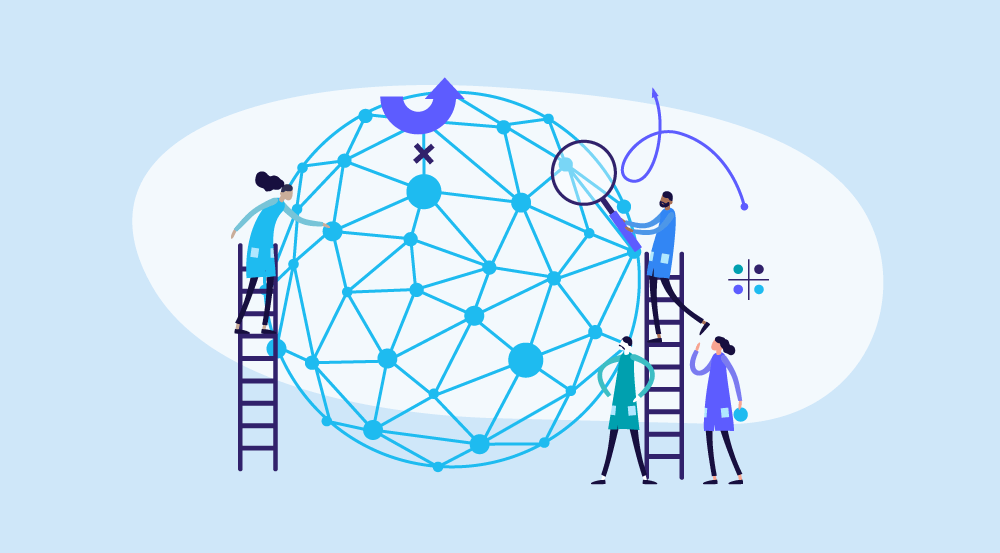According to a Gallup survey, only 32% of workers are actively involved in their jobs.
The survey also found that a small percentage of employees are mentally devoted to their work and actively contributing to their organizations.
These statistics are disheartening and businesses need new approaches to boost employee satisfaction and engagement.
So, what could be an effective approach to increase employee engagement? Job enrichment is emerging as a promising job enrichment strategy.
In this article, we will delve into the concept of job enrichment. We will explore its benefits and implementation strategies.
Job enrichment is about making a job more rewarding and fulfilling for employees.
It involves giving employees more responsibility, autonomy, and opportunities for growth and development.
By enriching their jobs, employees are more likely to feel a sense of ownership and purpose in their work.
This, in turn, leads to increased job satisfaction and engagement.
The benefits of job enrichment are numerous.
It can improve employee morale, motivation, and productivity. It can also lead to higher levels of employee retention and loyalty.
Furthermore, job enrichment can enhance creativity and innovation within an organization.
When employees are given more freedom and responsibility, they are more likely to come up with new ideas and solutions to problems.
Implementing job enrichment techniques requires careful planning and consideration. It is important to assess the current job roles and identify areas where enrichment can be applied.
This may involve redefining job responsibilities, providing additional training and resources, and creating opportunities for employee growth.
It is also crucial to communicate the changes effectively to employees, ensuring they understand the purpose and benefits of job enrichment.
To that end, it’s safe to say that it’s an ongoing process that needs to be refined with the help of job enrichment techniques.
We have handpicked these job enrichment strategies to help you get started easily.
Read on…
What Is Job Enrichment From Beginners’ Perspective?
Wondering what is job enrichment?
Job enrichment, from a beginner's perspective, refers to a work-related strategy that aims to make a job more fulfilling, satisfying, and motivating by increasing the variety, autonomy, and responsibility of tasks assigned to an employee.
The primary goal of the job enrichment technique is to enhance the overall work experience and engagement of individuals in their roles.
This concept was popularized by psychologist Frederick Herzberg as part of his two-factor theory of motivation.
For beginners in a job or career, a job enrichment program can be especially beneficial as it offers the following advantages:
Learning New Skills
Introducing job enrichment techniques entails adding extra duties and responsibilities to an employee's role.
To fulfill these responsibilities effectively, employees must acquire new skills.
These additional skills are essential for completing the assigned tasks successfully.
Job enrichment tends to be most beneficial for employees who are eager to acquire new skills to enhance their future prospects.
Increases Employee Motivation By Reducing Monotony
Motivated employees exhibit a 20% increase in performance, while highly engaged teams contribute to a 21% boost in business profitability.
Boosting motivation through job enrichment is achieved by introducing additional responsibilities to the employees within the company.
These added responsibilities create a diverse and engaging work environment.
The resulting diversity in tasks provides a renewed sense of energy and enthusiasm in carrying out the job, ultimately reducing monotony in the daily work routine.
This stands as a significant advantage of job enrichment techniques.
Fosters A Positive And Improved Working Environment
Implementing job enrichment is a strategic decision for the company, considering its potential benefits for organizational growth.
Once the company observes positive outcomes from the job enrichment initiative, it is likely that employees will also develop a positive attitude toward their new duties and responsibilities.
This kind of workplace environment can be seen as a step towards enhancing the company's overall well-being and the job satisfaction of its employees.
Enhances The Likelihood Of Recognition And Rewards
According to a survey, 53% of employees express their willingness to stay longer in a company if they feel appreciated.
Implementing job enrichment in a company increases the chances of employees receiving recognition and potential rewards for their dedicated efforts.
Fortunately, this process of rewarding and recognizing employees can inspire and motivate them to work even harder for their personal growth and career advancement.
Therefore, it is essential for employees to utilize job enrichment opportunities effectively.
Serves As A Motivational Factor For Career Advancement
The various elements of job enrichment offered by the company may add an extra workload to employees, but it also brings along an added source of motivation.
Employees are often driven to perform better in their roles, leading to advancements in the company's growth.
Hence, even a small amount of motivation can significantly impact one's professional life.
Instills A Sense Of Accomplishment
Job enrichment fosters a sense of accomplishment not only for the employees but also for the company or employer.
Although employers may introduce job enrichment to improve company profits and overall growth, it ultimately benefits the employees as well.
Thus, job enrichment holds importance for both employees and employers.
Reduces Absenteeism
Implementing job enrichment can potentially reduce workplace absenteeism, transforming the overall company outlook.
Employees become interested in exploring new tasks, which in turn minimizes time wasted on unproductive activities.
Understanding job enrichment is crucial for building a successful business empire.
For organizations, implementing job enrichment strategies for beginners can also have benefits, such as improved productivity, better employee morale, and a positive employer brand, which can attract top talent in the future.
It's essential to note that job enrichment is not a one-size-fits-all approach. The level of enrichment required may vary based on individual preferences, skills, and career aspirations.
Now that you know what is job enrichment, let’s move on to some of the techniques.
10 Job Enrichment Techniques To Harness Employee Empowerment
Without further adieu, let’s explore job enrichment program(s) and techniques that’ll help you to increase performance, productivity, and cross-cultural diversity in your organization.
Task Variety Vs Your Workforce
It's important to provide employees with a variety of tasks and assignments. This not only challenges their skills but also stimulates their intellect and ignites their creativity regardless of their differences.
When employees are given a range of tasks, it encourages them to think outside the box and explore different solutions to problems.
It also helps break up their mundane routines, giving them a much-needed break.
When employees have the opportunity to work on new and exciting challenges, it sparks their curiosity and enthusiasm.
They become more engaged and willing to invest their energy in their work.
Task variety also promotes continuous learning, as employees are constantly faced with new experiences and opportunities to expand their knowledge and skills.
Offering a diverse range of tasks also benefits the organization as a whole.
It helps identify employees' strengths and weaknesses, enabling managers to make better decisions about task assignments and team structures.
It also fosters a culture of innovation and adaptability within the workplace, as employees are constantly exposed to new ideas and ways of doing things.
Task Consolidation
When you combine tasks, you create a more challenging and complex work assignment.
This can make it easier for your team member to see a job through from beginning to end. It's an example of job crafting, where someone changes aspects of their current job to better suit their needs.
This approach encourages individuals to take the initiative to change and improve their own roles. It's especially useful in organizations with flatter structures, where a traditional career ladder may not exist.
By combining tasks, you give your team member the opportunity to have more ownership over their work.
They can see the entire process from start to finish, which can increase their sense of task identity.
It also allows them to develop a deeper understanding of the work they are doing.
Moreover, combining tasks can help keep employees engaged and motivated.
When they have a variety of tasks to work on, they are less likely to get bored or feel stagnant in their role.
It can also provide opportunities for learning and growth, as they may need to develop new skills or knowledge to successfully complete the combined tasks.
In conclusion, combining tasks can be a beneficial approach to increasing task identity and job satisfaction.
It allows individuals to take control of their own roles and provides opportunities for growth and development.
So, consider implementing this job enrichment strategy in your organization to create a more fulfilling work environment.
Work Rotation
Encourage your team members to try different roles within the organization and gain new skills.
This can boost their motivation, especially if they're stuck in repetitive jobs or ones that only require a few skills.
It's also a fantastic way to uncover potential improvements and foster collaboration as barriers between departments diminish.
By rotating jobs, your team can expand their knowledge and expertise while also finding new opportunities for growth.
They'll have the chance to step out of their comfort zones, learn from different perspectives, and contribute fresh insights to their new roles.
Additionally, this practice helps to break down silos and encourage cross-functional collaboration.
When team members shift to different roles, they can gain a deeper understanding of the entire organization, enhancing their ability to work together effectively.
So, consider implementing a job rotation program to provide your team with exciting challenges and help them develop a well-rounded skill set.
Identifying Critical Project-Focused Activities
Why not break away from traditional department structures and form project-focused teams instead?
Instead of having managers decide who works on what project and passing the work between different functional areas, you could divide the department into integrated multidisciplinary teams.
These teams could consist of market researchers, copywriters, and designers who collaborate together on specific clients or campaigns.
By allowing employees to build client relationships, you give them more autonomy and a stronger sense of task identity.
This, in turn, leads to more valuable feedback.
Creating these project-focused units can have numerous benefits.
Firstly, it encourages cross-functional collaboration, allowing team members with different expertise to work seamlessly together.
This can lead to more innovative solutions and a better overall outcome for the client.
It also fosters a sense of ownership and purpose, as team members are able to see the direct impact of their work on the success of the project.
Furthermore, by breaking away from traditional functional lines, you create a more flexible and agile working environment.
Project-focused teams can easily adapt to changing priorities and requirements, ensuring that projects are completed efficiently and effectively.
Overall, forming project-focused units can be a strategic move that boosts productivity, engagement, and client satisfaction.
Increase Autonomy Over Time
According to the findings of a recent study, 52% of employees experience a lack of autonomy in their work.
Granting autonomy to your employees is essential if you want them to take ownership of their work.
By having autonomy, they can exercise their independence and truly take charge of their responsibilities.
This will undoubtedly heighten their sense of responsibility and make them more accountable.
Furthermore, autonomy goes beyond just responsibility. It also fuels intrinsic motivation within employees.
When they have the freedom to pursue tasks aligned with their passions and strengths, they become more driven and enthusiastic about their work.
This, in turn, leads to higher productivity and better results.
Autonomy is about giving employees the space and trust to make decisions and take initiative.
It shows that you have confidence in their abilities and value their judgment.
It creates a sense of empowerment and encourages them to think creatively and come up with innovative solutions.
In summary, autonomy plays a crucial role in fostering employee ownership, enhancing engagement, and fueling intrinsic motivation.
By granting autonomy, you empower your employees to take charge of their work and make meaningful contributions to the organization.
So, consider giving them the autonomy they need to thrive and reach their full potential.
Broad Spectrum Decision Making
If you want to motivate your team, involve them in decision-making.
Make them feel like their opinions and ideas matter. This can be done through strategic planning and including them in the process.
It doesn't matter how big or small your organization is, this method can work for anyone.
When team members see that their input is valued, it makes them more motivated.
They feel like they have a voice and that they can make a difference.
This is important for employee engagement and overall satisfaction.
People want to feel like they are part of something bigger and that their ideas are being taken into consideration.
However, it's important to note that implementing this kind of change can be more difficult in larger organizations.
The bigger the organization, the more levels of hierarchy there are.
This can make it challenging to involve everyone in decision-making. In some cases, it may even be counterproductive.
Despite the challenges, it's still important to try to include as many team members as possible in decision-making.
Even if you can't involve everyone, try to include representatives from different departments or levels. This way, you can still get diverse perspectives and input.
Overall, widening decision-making is a great way to show your team members that their opinions matter.
It creates a positive work environment where everyone feels heard and valued. So, don't be afraid to give your team members a say in the decision-making process.
Feedback Systems
It's important to let your team members know how they're doing.
Giving them regular feedback shows that you appreciate their work.
As per the data, 65% of employees express a desire for more feedback.
Moreover, companies that offer regular employee feedback experience 14.9% lower turnover rates than those without such feedback.
Schedule performance reviews on a regular basis to provide employees with helpful feedback about their performance.
Take the time to offer advice on how they can improve in areas where they're falling behind. This will motivate them to enhance their performance.
Remember, the more you monitor and evaluate, the more fulfilling their jobs become.
Encourage them to evaluate their own performance and keep track of it.
Self-assessment empowers your employees to take control of their professional growth and development.
They can identify their strengths and weaknesses and set goals to improve.
In these performance reviews, make it a two-way conversation.
Ask them for their input and thoughts on how they can improve and grow.
Engage in open and honest discussions to create a supportive environment where employees feel comfortable expressing their concerns and asking for guidance.
Offer praise and recognition for their achievements and progress. Celebrate their successes and let them know their efforts are valued.
This boosts morale and encourages a positive attitude toward their work.
Ultimately, by providing regular feedback and support, you are investing in your team members' professional growth and development, leading to a more motivated and successful team.
Enriching Your Own Job If You’re In a Senior Position
If you want to enrich your job, talk to your manager about expanding your responsibilities. Bring up the idea during your one-on-one or appraisal meetings.
Show that you are ready to take on additional work and collaborate with others.
To strengthen your case, explain the benefits of being more engaged in your job and how it can improve your long-term productivity.
If the job enrichment can help address any performance issues within your team, highlight that as well.
Make sure you have a clear plan for what kind of job enrichment you are proposing.
Show that you have the skills to handle the new tasks and that it won't disrupt the team's workflow.
For example, if you're a marketing executive and you want to take on social media marketing, make sure it's not already someone else's responsibility.
You don't want to diminish someone else's role.
Remember, job enrichment is about expanding your skills and taking on new challenges. It's not about overloading yourself or causing problems within the team.
Communicate your ideas effectively and showcase how they can benefit both you and the company.
Site-Wide Employee Surveys
When it comes to understanding your employees, feedback alone is not enough.
It's essential to know their likes and dislikes about their jobs, and one way to do this is through surveys.
Surveys provide valuable first-hand opinions on your employees' regular experiences.
Employee surveys can be a powerful tool for success and achieving goals when done effectively.
By using the right tools, and metrics, and asking the right questions at the right time, you can uncover valuable insights from your employees.
For example, you could ask them questions like:
- Are you satisfied with your current job role?
- Do you find new projects or tasks exciting?
- On a scale of 1 to 10, how connected do you feel with your peers?
- Do you feel recognized for your hard work?
- Does your work align with the organization's goals and mission?
Their responses will provide valuable information that you can use to design effective strategies and make their jobs more relevant and enriching.
By listening to your employees' feedback and taking action based on their responses, you can create a positive work environment that fosters growth and success.
Surveys are not just a means of collecting data; they are a way to show your employees that their opinions matter and that you value their input.
Incentives, Rewards & Recognition
Appreciating employees is important because it leads to reciprocation in many ways.
Providing tangible acknowledgment, such as rewards and recognition programs, is crucial for enriching employees' jobs.
These programs give employees a sense of accomplishment and motivate them to strive for more.
The impact of rewards and recognition can be extremely positive, leading to increased performance and job satisfaction.
In fact, a well-designed program in this area can drive a significant 11.1% increase in average employee performance.
If your company doesn't already have such a program in place, it's worth considering implementing one.
However, if you're looking for a platform that offers a seamless experience in recognizing and rewarding your employees, your search ends with Oreed.
Revolutionize Employee Training With Oreed: The Future Of Learning
Unleash the Power of Data-Driven Learning, Personalized for Every Individual's Success
Empower Your Workforce with Personalized Learning Journeys.
Discover how Oreed's cutting-edge platform revolutionizes employee training by empowering individuals with personalized learning journeys.
Say Goodbye to One-Size-Fits-All Training Programs
Embrace a dynamic approach that caters to each employee's unique needs, preferences, and learning styles.
With Oreed, your workforce will thrive like never before, acquiring essential skills and knowledge in a way that truly resonates with them.
Unleash the Power of Advanced Analytics
Gain a 360-degree view of your employees like never before with Oreed's comprehensive insights.
Identify their strengths, pinpoint areas for improvement, and understand their training needs better than ever.
Armed with data-driven insights, you can make evidence-based decisions to optimize training efforts, ensuring that each employee receives precisely what they need to excel in their roles.
Tailor-Made Training for Unparalleled Performance
Transform your training programs with Oreed's ability to develop customized courses that address the unique strengths and weaknesses of your team members.
Gone are the days of generic workshops that may not resonate with everyone.
With Oreed, you can deliver targeted, relevant, and engaging learning experiences that maximize the potential of each individual, fostering a high-performing and motivated workforce.
Unravel the Impact of Training with In-Depth Analytics
Wondering how effective your training initiatives truly are?
Oreed has you covered with detailed analytics and reporting that measures the impact of your programs.
Track progress, assess results, and make data-backed decisions for continuous improvement.
By consolidating all learning experiences into one user-friendly platform,
Oreed empowers you to elevate productivity, efficiency, and profitability, driving significant bottom-line results.
Empowering Fundamental Learning Outcomes with Oreed
Oreed's innovative platform empowers organizations to improve fundamental learning outcomes in line with Vision 2030.
By offering personalized learning journeys, advanced analytics, and customized training, Oreed ensures that employees receive tailored learning experiences that address their unique needs and skill gaps.
This approach fosters deeper understanding, higher engagement, and increased knowledge retention, leading to significant improvements in overall learning outcomes.
Oreed's commitment to consolidating learning experiences into one user-friendly platform further supports a continuous learning culture, driving organizations toward achieving the objectives of Vision 2030.
The Future of Learning at Your Fingertips
With Oreed's advanced analytics, personalized learning journeys, and powerful training tools, the future of learning is within reach.
Revolutionize your employee training and unlock the full potential of your workforce with Oreed's innovative platform.
So why wait? Give Oreed a try today and see the difference it can make for your organization.
Promote lifelong learning through Oreed by experiencing the most powerful all-in-one training and development intelligent platform that streamlines all your organization's learning, training, and development activities in one place.





